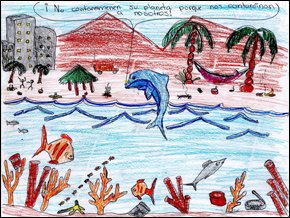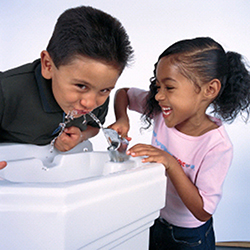|
ADEQ works to protect the quality of Arizona's surface waters (streams, lakes, rivers), aquifers (underground water supply) and drinking water sources from pollution. Pollution can make its way into our water through nonpoint and point sources, which can impact children's health and their environment if not properly managed.
Pollution Sources

Nonpoint Source Pollution (NPS) originates from various activities - from the daily maintenance of homes and gardens and washing cars to the more complex activities, such as farming, timber harvesting, mining, and constructing. NPS pollution comes from sources that are difficult to directly quantify. Homes can contribute to nonpoint source pollution because it is difficult to identify which homes may be dumping chemicals down drains, dumping used motor oil in the backyards, or having excess lawn chemicals run off into storm drains. Storm drain outlets often lead directly to lakes, streams, rivers, and wetlands.
Chucho Salva el Dìa (Video en español - Chucho te enseñará como mantener el agua limpia.)
To learn more about nonpoint source pollution:
Point Source Pollution or "wastewater" is the spent or used water from homes, communities, farms and businesses. Wastewater includes domestic sewage and industrial waste from manufacturing sources. Metals, organic pollutants, sediment, bacteria and viruses may all be found in wastewater. Because untreated wastewater can cause serious harm to the environment and threaten human life, ADEQ regulates the discharge and treatment of wastewater through permits. These permits establish specific discharge limits and require monitoring and reporting of the wastewater constituents. Permits may also require facilities to undertake special measures to protect the environment from harmful pollutants. Water Pollution Management Programs
ADEQ uses water quality permits to safeguard Arizona's waters that are affected by pollutants that come from identifiable sources. These permits protect groundwater and surface water quality by controlling discharges from domestic wastewater treatment plants, mining operations, industrial facilities, on-site sewage disposal systems, stormwater discharges to drywells, and the direct reuse of reclaimed water.
The Water Permits Section issues individual Aquifer Protection Permits, Arizona Pollutant Discharge Elimination System Permits and Reclaimed Water Permits. This section also authorizes discharges under general permits, registers drywells and certifies issuance of federal permits.
More information on Wastewater Management programs
Safe Drinking Water

"Drinking Water" is the water that comes out of your tap. This water is treated and distributed by your local water supplier. Water suppliers are regulated by ADEQ's Safe Drinking Water Section. Please visit the websites below for information on ADEQ's Water Quality Management programs:
ADEQ's Source Water Assessment and Protection Program assists public water systems and the communities they serve in managing and protecting their current and future drinking water sources.
The purpose of Source Water Protection, also known as drinking water protection, is to prevent harmful contaminants from entering your drinking water supply. ADEQ can assist in developing a plan of action customized to meet the needs and requirements of each public water system.
Some schools are not served by public water suppliers due to their remote locations. These schools must create and operate their own public water systems to provide safe drinking water to their students, staff and visitors. ADEQ is launching a new School Source Water Protection Technical Assistance Program that provides support for operators of such systems.
Surface Water
Surface water is protected by the federal Clean Water Act.  The Clean Water Act helps ensure that Arizona families are protected from waterborne diseases while they are boating, swimming and fishing. Under the Clean Water Act, every water body is designated for certain uses. Each type of use has its own specific rules to protect the surface water from pollution. Water bodies that are used for boating, swimming and fishing have more strict water quality standards. The Clean Water Act helps ensure that Arizona families are protected from waterborne diseases while they are boating, swimming and fishing. Under the Clean Water Act, every water body is designated for certain uses. Each type of use has its own specific rules to protect the surface water from pollution. Water bodies that are used for boating, swimming and fishing have more strict water quality standards.

A significant component of the Clean Water Act is the National Pollutant Discharge Elimination System Program. Arizona has authorization from EPA to operate this program on the State level (Arizona Pollutant Discharge Elimination System, or "AZPDES"). This program protects Arizona's surface waters by regulating point source discharges.
Other major components of the Clean Water Act include the requirement for states to assess the quality of their surface waters and to identify which water bodies need special attention in reducing the amount of pollutants that it receives. Assessments are conducted under Section 305(b) of the Clean Water Act and identifications are conducted under Section 303(d). The maximum amount of a water quality parameter that can be carried by a surface water body on a daily basis, without exceeding a water quality standard, is referred to as the Total Maximum Daily Load (TMDL). TMDLs are developed and adopted by ADEQ's TMDL Program.
ADEQ monitors the types of pollution contaminants that enter surface waters. Over the past several years, ADEQ has found increasing evidence of mercury contamination in lakes and streams throughout the Arizona. Mercury tends to accumulate as it moves up the food chain and it is nearly impossible to eliminate from the body. ADEQ has developed a "Mercury Strategy" that focuses on preventing new mercury from entering the environment and reducing the contributions from existing sources.
As part of the agency's statewide sampling program, ADEQ collects and analyzes fish from lakes and streams throughout the state. As a result of the fish tissue sampling, ADEQ has issued fish consumption advisories, primarily due to mercury in fish tissue on at least 12 water bodies throughout the state including Alamo Lake, Upper and Lower Lake Mary, Lyman Lake, and Parker Canyon Lake. Many of these water bodies have TMDLs completed on them and will have a water quality improvement implementation plan developed to help ensure that the quality of water will be restored to meeting standards.
Water Quality Improvement Grant (WQIG) Program
ADEQ's Water Quality Improvement Grant (WQIG) Program awards money through a competitive grant program for the implementation of nonpoint source pollution management and watershed protection. The distribution of grant funds from EPA is provided pursuant to Section 319(h) of the Clean Water Act and administered by the ADEQ Water Quality Division. These federal funds are granted to individuals, as well as public and private entities for implementing on-the-ground water quality improvement projects that reduce nonpoint source pollutant loadings to surface or ground water in Arizona.
Since 2000, ADEQ has awarded over $11 million dollars through the WQIG program. Of the 115 projects awarded, below are brief summaries of several projects that improved water quality in areas where children and families often recreate.
- July 2000: Forest Service Lower Salt River -- Pollution Prevention, Education, and Monitoring - monitoring water quality in the Lower Salt River "tubing area" and educating people how to keep the river clean for everyone to enjoy. Maricopa County
- January 2002: Boy Scouts of America, Camp Geronimo Project -- funds to replace and upgrade wastewater treatment facilities at the camp so that adjacent surface waters are protected from nitrogen and bacteria pollution. Navajo County
- January 2002: Upper Agua Watershed Partnership, Pilot Project to Clean up Dumpsites on the Big Bug Creek and Agua Fria -- awarded to a local watershed group to cleanup wildcat dumpsites in Big Bug Creek and the Agua Fria River near Cordes Junction. Yavapai County
- January 2003: Montessori de Santa Cruz School, Santa Cruz River Riparian Revegetation and Monitoring project -- awarded to friends of the Santa Cruz, the Montessori School and the Tumacacori National Historical Park Service to improve water quality along the Santa Cruz River by repairing riparian habitat, providing student training and monitoring and conducting community education and outreach. Santa Cruz County
See Also:
State and federal agencies can only do so much to protect water by writing laws. However, true water protection begins with each of us. Get Involved! There are many non-profit organizations and Arizona Watershed Partnerships that work on these issues.
Return to Arizona Children's Environmental Health Program Home Page
|